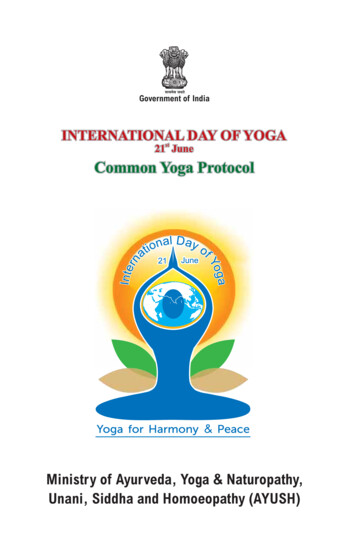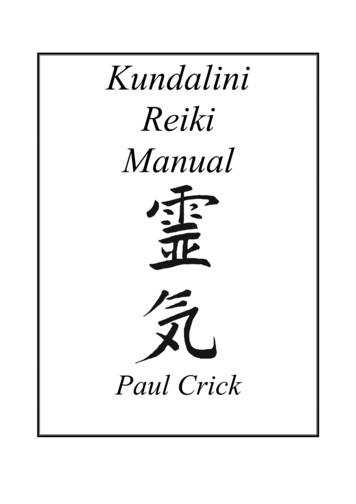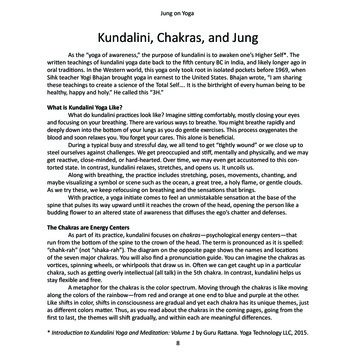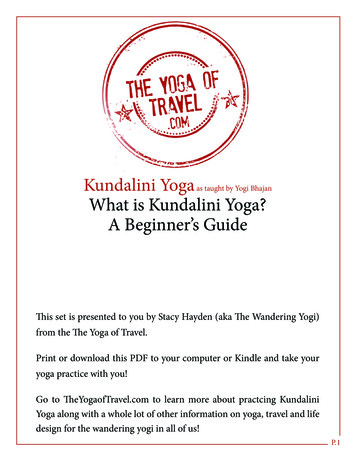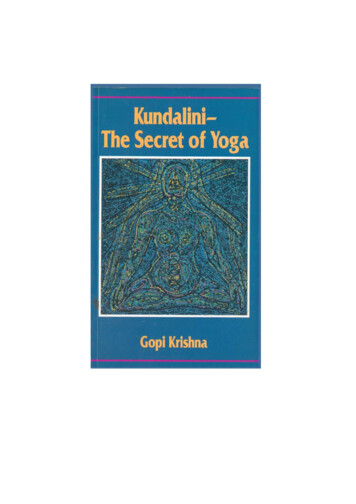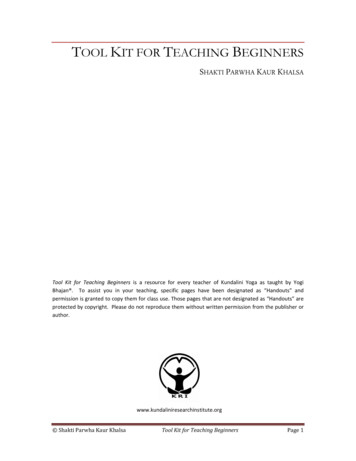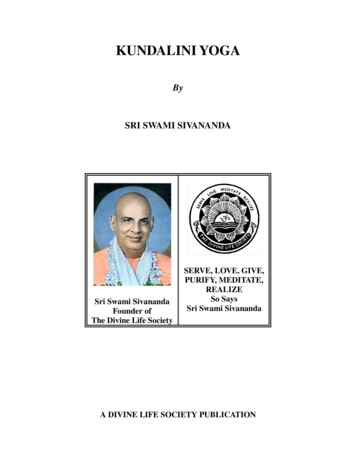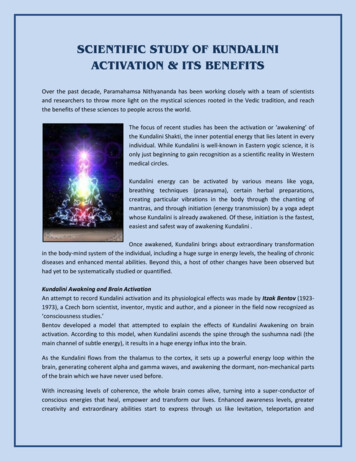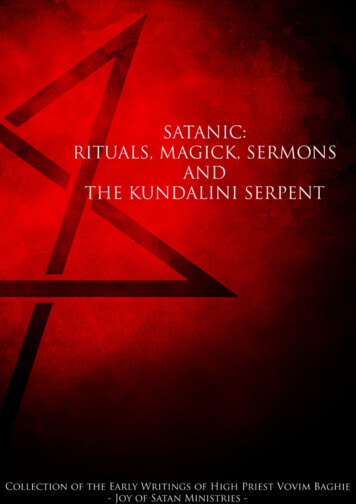
Transcription
“TUNING-IN” TO KUNDALINI YOGA: PHYSIO-SONIC EXPERIENCES IN APITTSBURGH YOGA STUDIObyAlison DeckerBachelor of Humanities and Arts, Carnegie Mellon University, 2007Submitted to the Graduate Faculty ofArts and Sciences in partial fulfillmentof the requirements for the degree ofMaster of ArtsUniversity of Pittsburgh2010
UNIVERSITY OF PITTSBURGHSCHOOL OF ARTS AND SCIENCESThis thesis was presentedbyAlison DeckerIt was defended onNovember 16, 2010and approved byAndrew N. Weintraub, PhD, Professor of MusicBell Yung, PhD, Professor of MusicThesis Director: Adriana Helbig, PhD, Assistant Professor of Musicii
Copyright by Alison Decker2010iii
“TUNING-IN” TO KUNDALINI YOGA: PHYSIO-SONIC EXPERIENCES IN APITTSBURGH YOGA STUDIOAlison Decker, M.A.University of Pittsburgh, 2010Kundalini Yoga classes in the United States have offered a holistic yoga practice with particularemphasis on chant (mantra) since the late 1960s. The use of the voice assumes a central positionin Kundalini Yoga as various forms of mantra, sound intentionally uttered to alter ones state ofconsciousness, are incorporated in every class. The ways in which mantra is used in KundaliniYoga presents epistemological questions concerning the ways sound shapes participants’experiences of the yoga class itself, of their own bodies, and more broadly of their own mindbody states of being. Is it possible to discover what it means for Kundalini Yoga participants toadd to a soundscape with their own voices? How important is each element of a Kundalini Yogasoundscape to the participants (i.e. breathing, mantra, background music), and how might theythink and talk about Kundalini soundscapes?An ethnographic case study within a weekly Kundalini Yoga class in Pittsburghdemonstrates the way its soundscapes can shape participants’ sensory experiences bysimultaneously restricting their fields of vision and redefining what it means to “listen.” Buildingon theoretical approaches drawn from phenomenology, this study explores kinestheticexperience by suggesting that the ways in which the sense of one’s physical state is intertwinedwith hearing in Kundalini Yoga (physio-sonic experience) enables practitioners to access adeeper level of emotional and physical consciousness which is activated and mediated by sound.iv
Through a repositioning of the body as the center of ethnomusicological fieldwork, thisthesis analyzes physio-sonic experiences of Kundalini Yoga activities, illuminating ways tolisten and engage with sound that join awareness of mind and body. Such experiences have leadregular participants to conceive of Kundalini Yoga practice not only as a way to balance andrefine their whole body-mind, but even in some cases to conceive of the practice as a model forhow to approach life outside of the yoga studio.v
TABLE OF CONTENTSPREFACE . IX1.0INTRODUCTION . 11.1PROJECT BACKGROUND . 51.1.1History of Kundalini Yoga in the United States. 61.1.2Discourse about the Kundalini Yoga Experience . 101.1.3“Tuning In”: The Role of Mantra in Yoga Classes . 151.1.4The Study of Sound in Relation to Metaphysical Experiences of Music 191.2METHODOLOGY . 241.3MANTRA AS INTENTIONAL VIBRATIONS . 272.0YOGI BHAJAN’S TEACHINGS . 312.1KUNDALINI YOGA AND RELIGIOUS AFFILIATION . 322.2KUNDALINI YOGA IN THE UNITED STATES . 343.0A PITTSBURGH YOGASCAPE . 433.1SPACE WITHIN A KUNDALINI YOGA STUDIO . 463.2CONSTRUCTIONS AND CONCEPTIONS OF TIME . 494.0MANTRA AS YOGIC SOUNDSCAPE . 544.1SOUND . 544.1.1Intention in Sound . 55vi
4.1.24.24.35.0Organization and Sound. 58FORMS OF MANTRA . 614.2.1Chanted Mantra . 624.2.2Spoken Mantra . 694.2.3Silent Mantra . 70ORIENTING MANTRA AND “SONIC DOMINANCE” . 73CONCLUSION. 89APPENDIX A . 93NON-ACADEMIC BIBLIOGRAPHY . 97vii
LIST OF FIGURESFigure 1. Adi Mantra. 15Figure 2. Easy Prayer Pose . 16Figure 3. Example of a different mudra. 44Figure 4. Shadyside Studio . 46Figure 5. Shadyside Yoga Space . 47Figure 6. Frog Pose . 51Figure 7. Sunshine Song . 56Figure 8. Ra Ma Da Sa . 66Figure 9. Adi Mantra (Phrase 2) . 76Figure 10. Transcription of Adi Mantra (Phrase 2) . 76Figure 11. Transcription of chanting among University of Pittsburgh participants. . 83Figure 12. Melodic Range Spectogram of Heart Chakra Exercise . 88viii
PREFACEMy experiences as an undergraduate studying music performance planted a seed that grew, overa number of years, into the impetus for this project. Over these years I have remained deeplyaffected by the training I received in areas such as Alexander Technique and eurhythmics, whichpushed me to question the ways in which I had previously been using my body. I had not reallythought about the possibilities for better, easier and even more enjoyable movement (either whilemaking music or not). In time, I began to think about my body in a very different way because ofhow I had been encouraged to use it for improved or enhanced music-making. This raised anumber of questions, namely: If making music can change one’s understanding of the body byopening up new perceptions of what it is capable of when employed in the most efficient ways,what could we learn by looking at music-making as a means to enhance the body?As I continued to develop these thoughts, I encountered a new activity which led to asecond shift in thinking about the facility of my body. For about three months at the end of asemester of study in Brazil, I attended Swasthya Yoga classes two times each week. Every classwas different, with a focus on maintaining balance between various yoga elements such asmeditation, mantra, and asanas, or body positions or poses. I grew to respect the holisticqualities of yoga, enjoying the balance created by pairing particular poses with one another, themusic played from an iPod to enhance our classes, and the occasional incorporation of sungix
mantra. I was influenced by the way in which the instructors spoke about state of mind. Theyurged students to keep a calm, peaceful attitude and facial expression even when our musclesburned and shook. Over time, I came to find a sort of peaceful euphoria in the feeling of pushingmy muscles to their limit while allowing my mind and my emotions to be calm. I came to findjoy above the discomfort of the physical challenge. The breathing exercises invigorated me, andso did the gradual mastering of particular poses that inevitably occurred the longer I worked onthem. I was astonished when I felt the pain present while holding one pose suddenly dissolve, asif I had pushed through some sort of “pain barrier.” Swasthya Yoga showed me that the humanbody is capable of many things, even when they do not seem possible.Walking to the yoga studio in my neighborhood, it was hard not to feel as though I wasbeing accosted by the environment around me. My ears were inundated by the noise of cars andbusses, sweat dripped down my face and back, grit from the street worked its way between mytoes, unprotected in flip flops. But the yoga studio in Brazil presented a contrast to the streetsoutside. Once inside the studio, every visitor would clean their feet, wiping off the dirt withtowelettes from the shelf. We would place our shoes in rows and step into the sitting room. Asoft, flokati rug and an excess of pillows covered the floor. The yoga studio greeted you withcool air conditioning, the smell of incense, and the spice of cardamom, cinnamon and gingerfrom the chai tea the instructors made daily.I was impressed by the way the instructors seemed to represent so vividly how life’sexperience can be enhanced through the practice of yoga. The instructors were kind, thoughtful,and calm. They always looked radiant, at peace, and at ease. Their bodies were strong and lean;they moved fluidly, like dancers. One instructor in particular demonstrated the way in which thesenses are supposed to be enhanced through yoga when he could tell what ingredient might havex
been missing from the chai just by smelling it from the other room. Through my practice there, Icame to conceive of yoga as a powerful and profound way to gradually experience life morefully.Swasthya Yoga is a practice specifically intended to enhance not just the body, but one’swhole mind-body and how one interacts with the rest of the world. In my experience ofSwasthya Yoga, sound was an integral part of meeting and reflecting upon the challenges of thepractice. Yoga seemed to present the perfect field for the exploration of sound and the body, witha hope of advancing a new perspective on the effects of music on the body, or on the types ofbodily engagement with music that are both powerful and inherent to music-making andlistening. I was finally able to pursue a project along these lines when I encountered KundaliniYoga in Pittsburgh, Pennsylvania.xi
1.0INTRODUCTIONI was drawn to Kundalini Yoga in Pittsburgh because participants play an important role increating the soundscapes of each class with their breath and their voices. While breathing is anelement of yoga practice which is emphasized in other yoga forms such as Ashtanga or HathaYoga,1the use of the voice assumes a central position in Kundalini Yoga. Various forms ofchanting, or mantra, are incorporated in every class. The ways in which mantra, soundintentionally uttered to alter ones state of consciousness, is used in Kundalini Yoga presentsepistemological questions concerning the ways sound shapes participants’ experiences of theyoga class itself, of their own bodies, and more broadly of their own mind-body states of being.It is important to understand the way yoga participants interact with sound in this contextbecause it may further illuminate ways to understand sensory experiences in a multitude of othercontexts in which the physical body interacts with sound – making vibrations, listening to them,or both.There have been many related studies which analyze the power of sound and alteredstates of consciousness (Rouget 1985) or deep emotional responses and different experiences ofthe “self” (Becker 1994, 2000, 2004), as well as the importance of the kinesthetic experience1The main difference between Kundalini Yoga and Hatha or Ashtanga Yoga is that Hatha and Ashtanga methodsespouse an emphasis on the movement or flow between a regular sequence of poses that is not present in KundaliniYoga. For sources on Hatha yoga (and which also mention ashtanga yoga) see Strauss (Positioning Yoga, 2005) andAlter (Yoga in Modern India, 2004).1
involved in making music (Yung 1984), dancing (Hahn 2007), or even in performing a martialarts-dance-game (Downey 2005). Questions regarding the role of sound in physical practices(such as yoga) in relation to spirituality and the personal cultivation of one’s own mind-bodystates, however, have not been fully explored in the field of ethnomusicology.While both Rouget and Becker explore the power of sonic experiences in regard totrance, the prospect of experiencing different mind-body states whether explained as a new levelof consciousness or an alternative “self” (a different “kind of person”)2is an important goal ofKundalini Yoga that is meant to be realized through engagement with mantra sound. In herwork, Becker aims to show that the “listening self” involved in trance ceremonies (when one isopen to or anticipates a different experience of self or personhood) “ may be the same bodybut may not be the same self as that inhabited in more commonplace life activities. Music, formany deep listeners, opens pathways of being not ordinarily experienced in everyday life.”3This study is meant to show how Kundalini Yoga and the sounds that are a central part of thepractice also offer various “pathways of being” that regular participants think of as significantlydifferent from everyday sensory interactions. Most importantly, in Kundalini Yoga these newexperiences of the self in relation to one’s environment are regarded as restorative experienceswhich bring balance and composure to the whole mind-body. Literature related to the restorativepowers (and experiences) of sound may be found in the field of music therapy as well as withinthe body of Indian-language publications on yoga, two significant areas which unfortunatelycannot be surveyed within the scope of this study.2Judith Becker, Deep Listeners: Music, Emotion, and Trancing (Bloomington, Indiana: Indiana University Press,2004), 88.3Ibid., 106.2
My aim here is to elucidate the ways in which the sounds of Kundalini Yoga, in thecontext of a particular environment, contribute to practitioners’ individual sensory experiences ofthe physical, mental and emotional manifestations of Kundalini Yoga practice. It is important toconduct research on Kundalini Yoga because of the potential for opening up new understandingsof voicing and listening that could provide a comparative perspective in the field of body-studiesand inform quantitative accounts in the field of music therapy.The site of my research is the Kundalini Yoga soundscape, the sonic environment, or asdescribed by the composer R. Murray Schafer, the “acoustic field.”4Throughout this study thecapitalized form of “Kundalini Yoga” or “Kundalini” will be used to refer to the specific brandof yoga that has been the fieldwork site for this study, while “kundalini yoga” or “kundalini” willrefer to other instances of yoga practice which are not specifically derived from the guru personaYogi Bhajan and his teachings.My relationship with Kundalini Yoga began with the inception of this project, with noprior notion of what Kundalini Yoga class would be like. Beginning in September of 2009, Ibecame a regular participant at weekly Kundalini classes, observing, listening, and partaking ofeach session’s offering of exercises, meditation, and mantra. I quickly realized that mantra wasnot only a main feature of Kundalini Yoga soundscapes, but that it was regarded as a veryimportant catalyst for activating the body’s energy and for raising participants’ levels ofconsciousness. This process of using sound to enact change in a person’s state of being has, infact, been the goal of kundalini-focused yoga as practiced in India for hundreds of years.Fieldwork in Pittsburgh has shown how sound dominates Kundalini Yoga, as does the word orconcept of “listening.” This focus on the aural surroundings creates an unusual composite4R. Murray Schafer, The Soundscape: Our Sonic Environment and the Tuning of the World (Rochester, Vermont:Destiny Books, 1977), 7.3
experience – one that is communal, in which participants chant together, listening to their full,combined sound and one that also becomes entirely self-centered, as participants are encouragedby the instructor to “listen” to their own bodies. Kundalini Yoga provides an opportunity to tuneinto a group endeavor and the long lineage of knowledge passing from master to student in theyoga tradition, while simultaneously allowing participants to leave behind the minutiae of dailylife to focus on their own thoughts, feelings and sensations for an hour and a half each week.Over a six month period attending classes from September (2009) to March (2010), Ihave come to regard Kundalini Yoga practice as an activity which is quite separate in place,time, and quality from the rest of my life. This time spent practicing Kundalini Yoga has led to anumber of research questions, including whether or not other participants experience KundaliniYoga in a similar way. Most importantly, what is the role of the sound, particularly the mantra,used in Kundalini Yoga practice? How exactly does Kundalini mantra affect or contribute to theenvironment of the yoga studio? Is it possible to discover what it means for Kundalini Yogaparticipants to add to a soundscape with their own voices? All of these questions are meant toaddress how the sounds that are created and heard almost exclusively 5 in a particular KundaliniYoga context (in Pittsburgh) shape the experience of participants. How important is each elementof a Kundalini Yoga soundscape to the participants (i.e. breathing, mantra, background music),and how might they think and talk about Kundalini soundscapes?5Recordings heard during class sessions would not necessarily be heard exclusively in class since they are fromCDs which can easily be bought from iTunes, Amazon, or even a nearby store in the neighborhood where classes areheld, Journeys of Life.4
1.1PROJECT BACKGROUNDIn order to seek out answers to these questions about the ways in which yoga participants interactwith and relate to Kundalini Yoga soundscapes, I began attending a Kundalini Yoga class thatmeets every Sunday morning in an upscale Pittsburgh neighborhood, Shadyside. As an “upscale”neighborhood, I mean that Shadyside is not only a neighborhood in which high-earning familiesand individuals reside, but one which serves as a prime shopping and entertainment locationoffering luxury goods and services.6The studio in Shadyside is just one branch of theSchoolhouse Yoga company (SY), which also offers classes in three other neighborhoodlocations.7My desire to explore the sonic element of yoga led me to look for classes inPittsburgh that explicitly incorporate mantra. Not knowing anything about Kundalini Yogainitially, I chose this Sunday morning class as the result of a casual Internet search. Of all of thethirteen classes offered at Schoolhouse Yoga, only the description of Kundalini Yoga posted onthe SY website listed mantra as one of its main components.8This particular version ofKundalini Yoga is a mixed formulation of the teachings and methods of Yogi Bhajan, the manwho is credited with bringing Kundalini Yoga to the United States. This study analyzes the ways6Kundalini Yoga classes in Pittsburgh seem to attract a certain demographic made up of middle/upper-middle class,mostly Caucasian (but also Latina), mostly female practitioners. This is supported by data collected about Healthy,Happy, Holy Organization (3HO) members in the 1970s and will be discussed in Chapter 2. Neighborhood censusinformation from 2000 confirms the larger number of high-earning Pittsburghers who reside in Shadyside comparedto other neighborhoods. Pittsburgh City Planning, “2000 City of Pittsburgh Neighborhood Census Report,” City ofPittsburgh Website, 2000 census pgh jan06.pdf (accessedSeptember 26, 2010).7The Strip District, South Side, and Squirrel Hill neighborhoods may not be labeled as upscale in the same way asShadyside, but they have been targeted areas for commercial development and are marketed as leisure andentertainment destinations for Pittsburgh’s many students “This class will introduce students to the tradition of Kundalini Yoga. All levels and backgrounds are welcome.Classes will focus on specific chakras (energy centers) of the body. Kundalini yoga incorporates breath work, asana(yoga postures), mantra (sound & rhythm), meditation, and relaxation. This style of yoga is renown [sic] for itsability to heal students emotionally.” “Classes,” Schoolhouse escriptions (accessed January 15, 2010).5
in which his teachings on mantra are interpreted and incorporated into classes by the SYinstructor, Kendell Romanelli.1.1.1History of Kundalini Yoga in the United StatesThe form of Kundalini Yoga available in Pittsburgh through Schoolhouse Yoga is basedon the teachings of Yogi Bhajan, although it is not affiliated with or sponsored by the Healthy,Happy, Holy (3HO) or the Kundalini Research Institute (KRI) organizations associated with him.The instructor, Kendell Romanelli, has had no specific Kundalini instruction, although she usesbooks written by members of the 3HO organization and students of Yogi Bhajan (to be discussedbelow) to teach her Kundalini Yoga classes. Two such student-authors, Dharam S. Khalsa (2002)and Shakti Parwha Kaur Khalsa (1996) both cite their training directly through the instruction ofYogi Bhajan in their books. Kendell’s teaching also relies on her experiences taking classes inKundalini Yoga studios on the west coast and activities like the chant workshop she attended inJune 2010, led by Snatam Kaur, a second generation student of Yogi Bhajan.Decades after Yogi Bhajan’s initial arrival in the United States from India and years afterhis death in 2004, the transmission of his form of Kundalini Yoga now clearly manifests in manydifferent (regulated and unregulated) ways. Kundalini instruction that takes place within the3HO organization is likely to be held to different or more rigorous standards than instructionwhich takes place beyond the organization’s reach. Kendell, for example, very often incorporatesnon-Kundalini Yoga elements (extra time for recuperation between exercises, for example) intoher classes. Therefore, despite the regulatory activities of the 3HO and KRI organizations, theinstitutionalized framework established by Yogi Bhajan is not all-encompassing. As is shown bythis local example in Pittsburgh, the widespread instruction and practice of Yogi Bhajan’s6
Kundalini Yoga manifests as an interpretive form that allows for individual articulations of thetradition.Kundalini Yoga’s origins were apparent to a much greater extent in its initial, singularpresentation in the United States. Kundalini yoga is an Indian tradition that is described ashaving been taught only privately, secretly being passed down from master to disciple.9It wasintroduced and spread throughout the United States beginning in 1969, when Harbhajan SinghPuri, more widely known as Yogi Bhajan, came to the country to teach yoga. Yogi Bhajan isreported to have been the first person to teach kundalini yoga publicly (beginning in the US),10having also been pronounced a Master of kundalini yoga at the young age of sixteen. 11 AlthoughYogi Bhajan’s name may not be familiar to many Americans, he became an extremely influentialfigure in the West during the second half of the twentieth century. The projects that he workedon, for example, his promotion of the Sikh religion and the mass marketing of his tea recipe asYogi Tea, continue to be incredibly wide-reaching. Yogi Tea has become one of the “leading teacompanies in the health food market in the USA and Europe.”12By supporting and promotingthe Sikh religion, Yogi Bhajan helped American Sikhs to gain legal recognition in the UnitedStates in the early 1970s, 13 leading to the development of the Sikh Dharma International9Shakti Parwha Kaur Khalsa, Kundalini Yoga: The Flow of Eternal Power (New York: Penguin Putnam, 1996), 6.Ibid., 6.11Dharam S. Khalsa and Darryl O’Keeffe, The Kundalini Experience: Bringing Body, Mind, and Spirit Together(New York: Simon & Schuster, 2002), 15.12“Siri Singh Sahib Bhai Sahib Harbhajan Singh Khalsa Yogiji,” The Sikh Network,http://fateh.sikhnet.com/yogibhajan (accessed March 10,2010).13In his article for the Encyclopedia of Diasporas, cultural anthropologist Bruce La Brack explains that the periodfrom 1900 to 1965 in the history of Sikh immigration to the US was shaped by “ persistent and blatant legalgovernmental discrimination in the form of a series of exclusionary acts, extreme social isolation and prejudice”(1095). It was not until after Indian independence (1947) that “ Sikh immigrants from India, as well as long-termresident Sikhs, were able to gain the right to vote, own land, hold passports, travel freely, demand equal protectionunder the law, and participate fully as citizens as they so chose” (1097). After fifty or so years of such treatment(directed not only towards Indians but to Chinese and Japanese immigrants as well), it is likely that Yogi Bhajan metwith some remnants of discrimination against Sikhs when he came to California in the late 1960s, and that it is thishistory against which he fought as a Sikh representative.107
organization. This accomplishment was eventually recognized by the United States Congress in aresolution following Yogi Bhajan’s death in 2004.14Yogi Bhajan’s original vehicle for imparting his knowledge of kundalini yoga was theorganization he founded, 3HO: Health, Happy, Holy Organization. Based in California, 3HOgrew quite rapidly – under Yogi Bhajan’s “ guidance as Director of Spiritual Education, 3HOmushroomed worldwide, to 300 centers in 35 countries. In 1994 3HO became a member of theUnited Nations as an NGO (Non-Governmental-Organization) in Consultative Status (Roster)with the Economic and Social Council, representing women's issues, promoting human rightsand providing education in alternative systems of medicine.”15As Yogi Bhajan’s reachbroadened, he gained greater power and influence not only through an increased audience, butthrough the legitimization of official international recognition.As 3HO expanded, Yogi Bhajan taught Kundalini Yoga classes in ashrams, or centerscreated for yoga practice and related activities, such as gatherings of devotees who would cometo listen to Yogi Bhajan’s teachings. Yogi Bhajan also spoke in parks and other cultural orcommunity centers, and created more intensive festivals for the practice of Kundalini Yoga aswell as initiation into Sikhism. The Summer Solstice Celebration, for example, consists of aweek of camping in New Mexico filled with yoga instruction, lectures, music, etc. This festivalstill takes place each summer, forty years after its inception.As a way of regulating and preserving the information that he shared with students, YogiBhajan established the Kundalini Research Institute (KRI) in 1972. The KRI is a non-profitBruce La Brack, “Sikhs in the United States,” in Encyclopedia of Diasporas: Immigrant and Refugee CulturesAround the World, Volume 2, ed. Melvin Ember et al. (New York: Kluwer Academic/Plenum Publishers, 2004).14Honoring the life and contribution of Yogi Bhajan, a leader of the Sikhs, and expressing condolences to the Sikhcommunity on his passing, S. Res. 148, 108th Cong., 2nd sess., S.148:: (accessed March 10, 2010).15“Siri Singh Sahib Bhai Sahib Harbhajan Singh Khalsa Yogiji,” The Sikh Network,http://fateh.sikhnet.com/yogibhajan (accessed March 10,2010).8
corporation, which “ safeguards the purity, integrity, and accuracy of the Teachings of YogiBhajan.”16The thirteen full-time staff members at the institute currently maintain a library ofYogi Bhajan’s teachings (mainly audio and video recordings) and develop teacher trainingcertification programs. They are also responsible for awarding the “ KRI Seal of Approval toproducts that successfully meet the standards of KRI Review,” or carrying out the process bywhich KRI staff deem a new product a successful and accurate conveyance of Yogi Bhajan’steachings. KRI also sells an approved collection of books, CDs, DVDs, digital downloads, andeven photographs advertised as coming from “the source” (or, the ultimate authority, as opposedto a periphery distributor who merely cites or reinterprets Yogi Bhajan’s teachings) and availableon the KRI
mantra) since the late 1960s.The use of the voice assumes a central position in Kundalini Yoga as various forms of mantra, sound intentionally uttered to alter ones state of consciousness, are incorporated in every class. The ways in which mantra is used in Kundalini Yoga presents epistemological questions concerning the ways sound shapes participants'
